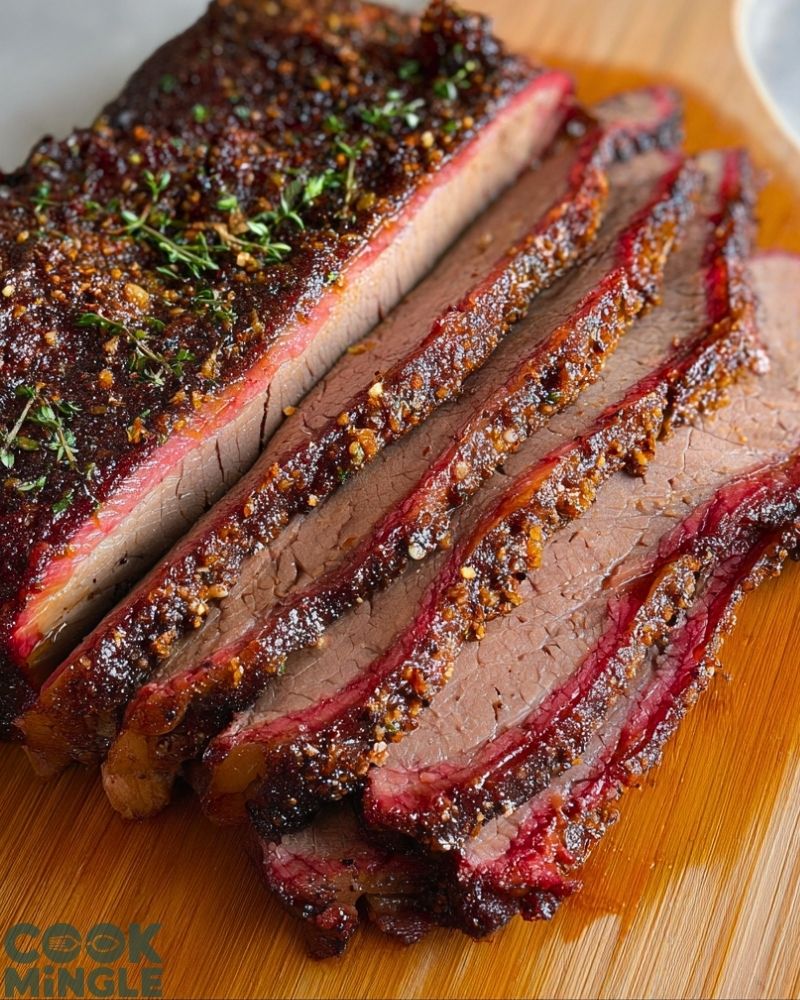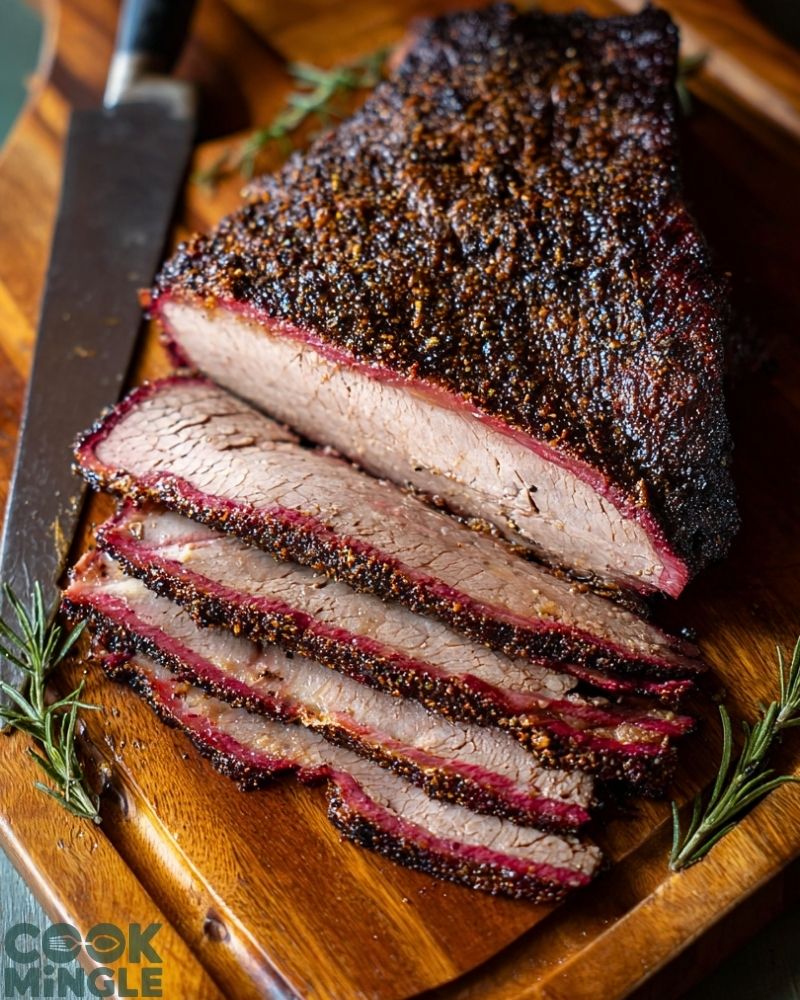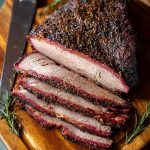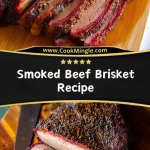I’ve always had a soft spot for slow-smoked meats, and few things satisfy quite like a well-prepared Smoked Beef Brisket. The first time I nailed the bark, smoke ring, and that tender slice that falls apart with the nudge of a fork—I knew I was hooked. It’s not just a recipe; it’s a ritual. The slow process of coaxing out flavors with smoke, patience, and the right rub makes it one of my favorite cooking experiences.

What I love about brisket is its humble transformation. It starts as a tough cut of meat, but with time and low heat, it turns into something extraordinary—smoky, juicy, deeply flavored. Whether I’m cooking for a crowd or prepping leftovers for the week, brisket never disappoints. And once you’ve tasted brisket smoked to perfection, there’s just no going back.
Why You’ll Love This Smoked Beef Brisket Recipe
This smoked brisket recipe delivers melt-in-your-mouth slices, a beautiful bark, and a deep smoke ring that will impress any barbecue lover. It’s ideal for backyard cookouts, weekend gatherings, or just because you want to treat yourself to something truly special. Whether you’re a first-time smoker or a seasoned pitmaster, this method is approachable, rewarding, and packed with flavor.
What Cut of Brisket Should I Use?
When it comes to smoking brisket, choosing the right cut makes all the difference. I always recommend going with a packer brisket, which includes both the point and the flat. The flat is leaner and slices beautifully, while the point has more fat and delivers that juicy, tender bite. If you’re just starting out or cooking for a smaller group, the flat alone can still produce great results—just make sure not to overcook it.
Look for a brisket with good marbling and a flexible feel when you pick it up. That means the connective tissues are ready to break down during a long smoke. USDA Prime or Choice grade usually gives the best balance of fat and quality without being overly expensive.
Options for Substitutions
If brisket isn’t available, or you’re looking to mix things up, you can try a few alternatives:
- Chuck Roast: Similar texture and flavor when smoked low and slow. Great for smaller servings.
- Beef Short Ribs: These bring a lot of marbling and smoke beautifully, though cook times will differ.
- Tri-Tip: Not traditional, but it smokes well and cooks faster for a weeknight option.
- Pork Shoulder: A totally different cut, but it uses the same method of low-and-slow cooking for pulled pork.
Even with substitutions, the essence of this recipe—smoke, seasoning, and patience—still brings you rich, satisfying results.
Ingredients for This Smoked Beef Brisket Recipe
- Whole Packer Brisket (10–14 lbs)
This is the star of the show. You need both the point and flat for a perfect balance of texture, moisture, and flavor. - Kosher Salt
Salt penetrates deep into the meat during the long smoke, enhancing the beef’s natural flavor. - Coarse Black Pepper
Essential for creating that classic Texas-style bark—crusty, flavorful, and just the right amount of bite. - Smoked Paprika
Adds a subtle smoky depth that works beautifully with the wood smoke. - Garlic Powder
Brings warmth and complexity to the rub, rounding out the seasoning profile. - Onion Powder
Enhances the savory richness of the beef and complements the garlic. - Brown Sugar (optional)
Just a touch helps balance the savory rub with a hint of sweetness and aids in caramelization. - Yellow Mustard (binder)
Helps the dry rub stick to the meat and contributes to the bark formation without affecting flavor. - Wood Chips or Chunks (Oak, Hickory, or Mesquite)
These provide that crucial smoke flavor—each wood type brings its own boldness and aroma.

Step 1: Trim the Brisket
Start by trimming the brisket to remove any silver skin and excess fat. Leave about 1/4 inch of the fat cap to keep the meat moist during the long cook. Square off the edges for even smoking.
Step 2: Apply the Binder and Rub
Rub a light layer of yellow mustard over the entire surface of the brisket. It won’t affect the flavor but helps the seasoning stick. Generously apply your rub: a mix of kosher salt, coarse black pepper, smoked paprika, garlic powder, onion powder, and a little brown sugar if you like.
Step 3: Let It Rest Before Smoking
Let the seasoned brisket sit at room temperature for 30–60 minutes. This lets the rub settle in and the meat temper before it hits the smoker.
Step 4: Preheat Your Smoker
Set your smoker to 225°F. Choose your wood—oak for balanced smoke, hickory for richness, or mesquite for boldness. Make sure there’s consistent smoke flow, not thick white plumes, which can make the brisket bitter.
Step 5: Smoke the Brisket Low and Slow
Place the brisket fat-side up on the smoker. Insert a meat thermometer into the thickest part of the flat. Smoke at 225°F until the internal temp reaches 165°F—this usually takes about 6–8 hours depending on size.
Step 6: Wrap the Brisket
Once it hits 165°F, wrap it tightly in butcher paper or foil to push it through the “stall” (where it seems to stop rising in temp). Return to the smoker and continue until the internal temperature reaches 200–203°F.
Step 7: Rest Before Slicing
Remove the wrapped brisket and let it rest in a cooler or warm oven (turned off) for at least 1 hour. This step is critical—resting redistributes the juices and softens the texture.
Step 8: Slice and Serve
Unwrap your brisket, slice against the grain, and serve. The point section will be fattier and perfect for juicy bites, while the flat gives you uniform slices ideal for sandwiches or platters.
How Long to Cook the Smoked Beef Brisket
Smoking brisket is a time commitment, but the results are always worth it. Plan for 1 to 1.5 hours of cook time per pound at 225°F. For a 12-pound brisket, you’re looking at roughly 12 to 18 hours total, including resting time. The key is cooking to internal temperature, not just time—aim for 200–203°F for that perfect tenderness.
Remember, there’s a stall around 150–165°F where the meat seems to stop cooking. Don’t panic—that’s when you wrap the brisket and power through the stall. It’s all part of the process.
Tips for Perfect Smoked Beef Brisket
- Trim Smart: Leave enough fat to protect the meat, but not so much that it prevents seasoning and smoke from penetrating.
- Season Generously: Don’t be shy—brisket is a big cut that needs a bold rub.
- Use a Meat Thermometer: Internal temperature is your best friend here. Avoid guessing.
- Don’t Rush It: Low and slow wins every time. Keep your smoker steady at 225°F.
- Wrap Tightly: Butcher paper allows for some breathability, which keeps the bark crusty.
- Let It Rest: One hour minimum, two is even better. Skipping this will dry out your brisket.
- Slice Against the Grain: Always. It makes every bite more tender and easier to chew.
Watch Out for These Mistakes While Cooking
- Skipping the Trim: Leaving too much fat or silver skin can ruin the bark and prevent seasoning from sticking.
- Inconsistent Temperature: Fluctuating smoker temps can lead to uneven cooking. Use a reliable thermometer and adjust vents or fuel as needed.
- Opening the Lid Too Often: Every time you check, you lose heat and smoke. Trust the thermometer.
- Under-seasoning: Brisket needs a bold rub to bring out its flavor. Don’t go light-handed.
- Not Wrapping at the Stall: If you wait too long, the brisket may dry out before reaching the right temp.
- Skipping the Rest: This is when juices redistribute and the meat softens. Don’t slice too soon.
- Slicing the Wrong Way: Always cut against the grain for maximum tenderness.
What to Serve With Smoked Beef Brisket?
Classic Coleslaw
Crunchy, creamy, and a perfect cool contrast to smoky meat.
Cornbread
Sweet and buttery, it soaks up brisket juices like a dream.
Pickled Red Onions
Bright and tangy, they cut through the richness of the beef.
Baked Beans
Hearty, slightly sweet, and smoky—an unbeatable sidekick.
Grilled Corn on the Cob
Charred and slightly sweet, a natural pairing with BBQ flavors.
Potato Salad
Creamy, tangy, and satisfying alongside brisket slices.
Mac and Cheese
The ultimate comfort food that’s right at home on a BBQ plate.
Texas Toast
Thick, buttery slices that help mop up every bit of sauce and brisket drippings.
Storage Instructions
Leftover brisket stores beautifully and might even taste better the next day. Let the meat cool completely, then slice and store it in an airtight container. Add a bit of the leftover juices to keep it moist.
- Refrigerator: Keeps well for up to 4 days.
- Freezer: Wrap tightly in foil and place in a freezer-safe bag. It’ll last up to 3 months.
- Reheating Tip: Reheat slices wrapped in foil at 300°F with a splash of broth or juices to keep them tender.
Estimated Nutrition
Per 6-ounce serving (without sides or sauce):
- Calories: ~430
- Protein: ~38g
- Fat: ~28g
- Saturated Fat: ~11g
- Carbohydrates: ~2g
- Fiber: 0g
- Sugar: ~1g
- Sodium: ~480mg
- Cholesterol: ~110mg
Keep in mind this will vary slightly depending on your rub ingredients and trimming.
Frequently Asked Questions
How do I know when brisket is done?
It’s done when the internal temperature hits 200–203°F and a probe slides in like butter with no resistance. That’s your best sign.
What’s the stall and how do I get through it?
The stall happens when moisture evaporates from the brisket around 150–165°F, causing the internal temp to plateau. Wrap the brisket in butcher paper or foil to push through it.
Should I smoke fat-side up or down?
Fat-side up is common, allowing fat to render down into the meat. But fat-side down can protect the brisket from direct heat if it’s coming from below. It depends on your smoker setup.
Can I smoke a smaller brisket?
Absolutely. Just adjust the cook time—plan for 1 to 1.5 hours per pound and use a thermometer to track doneness.
What’s the best wood for smoking brisket?
Oak is a classic choice—balanced and steady. Hickory adds boldness, while mesquite brings an intense smoky flavor for those who like it strong.
Can I make brisket ahead of time?
Yes. It holds well in a cooler or low oven for hours. You can also fully cook and reheat it the next day—it reheats well when sliced and wrapped.
Why is my brisket dry?
Dry brisket can come from overcooking, not enough fat, skipping the rest phase, or slicing it the wrong way (with the grain). Proper technique is key.
How much brisket should I plan per person?
Plan on ½ pound per person for sliced brisket, or ¾ pound if you want leftovers or bigger portions.
Conclusion
Smoking a brisket takes patience, but once you nail it, there’s nothing quite as satisfying. From the sizzle of the first trim to the aroma of the smoke and that final juicy slice—it’s a labor of love that delivers big time. Whether you’re impressing friends or savoring it solo, this Smoked Beef Brisket recipe will earn a spot in your permanent rotation.
Ready to print and smoke your own masterpiece? Let’s get the printable version set up next.

Smoked Beef Brisket Recipe
- Total Time: 13–19 hours
- Yield: 12 servings
Description
A smoky, tender Smoked Beef Brisket that melts in your mouth with a rich bark and deep flavor. Perfect for BBQ gatherings or a special weekend cookout. This recipe walks you through every step—from trimming to smoking and slicing for a true Texas-style experience.
Ingredients
1 whole packer brisket (10–14 lbs)
2 tablespoons kosher salt
2 tablespoons coarse black pepper
1 tablespoon smoked paprika
1 tablespoon garlic powder
1 tablespoon onion powder
1 tablespoon brown sugar (optional)
2 tablespoons yellow mustard
Wood chips or chunks (oak, hickory, or mesquite)
Instructions
1. Trim the brisket, removing silver skin and leaving about 1/4 inch of fat cap.
2. Rub yellow mustard over the brisket to help the rub stick.
3. Apply the seasoning mix evenly across the brisket.
4. Let the meat rest at room temperature for 30–60 minutes.
5. Preheat your smoker to 225°F with your choice of wood.
6. Place brisket fat-side up in the smoker and insert a thermometer.
7. Smoke until internal temp reaches 165°F (about 6–8 hours).
8. Wrap in butcher paper or foil and return to smoker.
9. Continue cooking until internal temp hits 200–203°F.
10. Rest wrapped brisket in a cooler or warm oven for at least 1 hour.
11. Slice against the grain and serve.
Notes
Store leftovers in the fridge for up to 4 days or freeze for up to 3 months.
Reheat gently with a splash of broth to keep moist.
Serve with sides like coleslaw, cornbread, pickled onions, and baked beans.
- Prep Time: 30 minutes
- Cook Time: 12–18 hours
- Category: Main Course
- Method: Smoking
- Cuisine: American BBQ
Nutrition
- Serving Size: 6 ounces
- Calories: 430
- Sugar: 1
- Sodium: 480
- Fat: 28
- Saturated Fat: 11
- Unsaturated Fat: 15
- Trans Fat: 0
- Carbohydrates: 2
- Fiber: 0
- Protein: 38
- Cholesterol: 110

